 |
||
|
||
| ||
The company Chaintech Computer is well-known. This corporation became widely known after the appearance in market with the whole range of system boards. The most popular from them was 6BTM. Since then the corporation could win a good name among the users delivering the whole series of both system boards and other products. I should mark that having offered a wide enough range of products by the way of system boards, the corporation paid attention and on videocards which soon began to appear in the computer market. Hardware products from Chaintech are distinguished by soundness, excellent fulfilment and rather low prices of production. Recently the company set its efforts on the release of the videocards on the chips from NVIDIA. Nowadays there is no videochip from NVIDIA which the corporation didn't release its version of the videocard on. I want to mark that almost all videocards under the trade mark Chaintech represent practically the exact copy of the reference card, and have no doubt in their reliability and the operation stability. Unfortunately the cards from Chaintech based on of new chips from NVIDIA appear later then the rest of competitors, however their rather low price gives a quite good chance for the cards to be in demand in our market. And now we have got the card Desperado RI90. Chaintech Desperado RI90 cards have already appeared on sale, and we are ready to present our report on testing. Furthermore it is possible to see the complete Retail-delivery that is a doubtless advantage. I shall repeat that the price is one of lowest. So we shall examine this card from the new series of accelerators GeForce2 GTS from Chaintech - Desperado RI90. The cardThe basic characteristics Chaintech Desperado RI90:
To not repeat we shall not describe in detail the features of GPU GeForce2 GTS from NVIDIA. Let's look now at the card: The card has AGP2x/4x interface, 32 MBytes 6 ns DDR SGRAM of memory placed in 8 chips posed on both sides PCB. 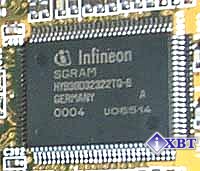 The memory chips are produced by the corporation Infineon and 166 MHz are planned on the operating frequency 166 MHz. The memory functions on this frequency. I shall note that sometimes the resulting values of the clock rate DDR memory which are twice more and look more impressively are given, though it doesn't change the essence. That is if it is said that the operation frequency of DDR-memory is 333 MHz, then actually it works on the frequency 166 MHz. The further survey PCB has shown that the videocard doesn't differ from the reference card. The perfectly constructed active cooler of the spherical form which we already could see on ASUS AGP-V7700 cards is installed on GPU. The daughtercard with TV-out on the given copy Chaintech Desperado RI90 is absent. The card is deep yellow which is the traditional colour of cards from the corporation Chaintech. On PCB there are also some places for wiring the daughter card with TV-out. Also on the videocard there is the empty place for installation the plug for connection the digital screen monitors. The videocard is delivered in Retail-packing. The box is fulfilled in traditional for Chaintech design. 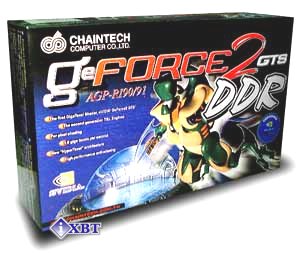 The delivery contains the installation guide and CD - disk with drivers. OverclockingTo the overclockers pleasure the given copy of the videocard could please the fans of overclocking by its potential. We managed to achieve the stable operation of the graphics core on frequency 235 MHz and memory - 395 MHz. These are one of the highest digits among the cards already examined by us. Therefore we expect the good increase on performance. Installation and driversNow here is the practical part of our review. For the beginning I shall present the test configuration: Pentium III based testing platform:
The operation with any videocard starts with the drivers installation. Therefore we also shall begin with them. At testing the drivers from NVIDIA of the version 6.18 were used. The reference drivers from NVIDIA are delivered with the videocard but of the older version. I shan't examine the drivers features because of the lack of Chaintech special achievements in the. It is possible to acquaint with them in our previous reviews or in the specialised articles published on our site. Test resultsWe shall start with the 2D-graphics. In the previous materials we already marked the excellent quality and speed in 2D mode which were demonstrated by cards based on GeForce2 GTS from NVIDIA. I can only state that for the card Chaintech Desperado RI90 all the results in 2D are at the same level (the complete repetition of the standard design from NVIDIA has an effect). The videocards of the similar class answer the needs in the qualitative image of the users. We shall examine the high-speed results Chaintech Desperado RI90 in 3D-graphics with the help of two games:
These instruments are quite enough to show the videocard performance at operation through two fundamental APIs. For visualisation on the diagrams you can see the high-speed metrics of two videocards: AOpen PA256 Deluxe and the reference card from NVIDIA based on GeForce2 GTS. Also we shall show how the performance of the Chaintech Desperado RI90 has varied at operation on not regular frequencies. 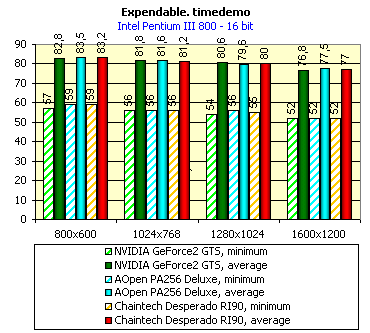 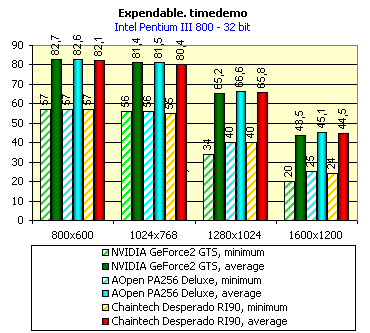 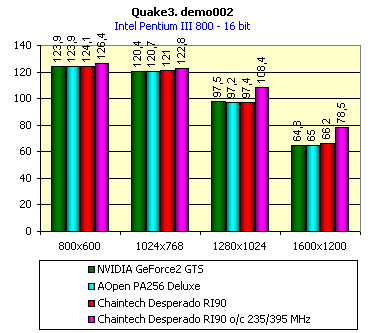  It is easy to note that the results in Quake3 and Expendable on performance of the Chaintech Desperado RI90 almost do not differ in whole from the results of the reference card from NVIDIA. The results obtained by operation on not regular frequencies (i.e. in the overclocking mode), are visible practically at once. The increase on speed is rather appreciable especially in the high resolutions. The overclocking on memory has had the good effect also on performance in 32-bit colour. I shall mark that the card from Chaintech worked at minimum external additional cooling (in the system block only one additional ventilator for good circulation of air was installed. Certainly I can not extrapolate the results of the given card overclocking on all cards based on GeForce2 GTS, however we can hope that the fans of overclocking can select the proper copy for their experiments. ConclusionSo the given copy of the Chaintech Desperado RI90 is a usual serial card which are already on sale. The results of tests have shown that Chaintech Desperado RI90 is as good as the reference card from NVIDIA. This card is attractive by the low price in relation to the competitors. Thus already today the user can purchase NVIDIA GeForce2 GTS card by the smaller price ($240-260) than the videocards based on GeForce 256 with memory like DDR SGRAM onboard had at the very beginning of sales ($300). The prices are falling and besides the price difference between them and the cards based on GeForce 256 with memory like DDR SGRAM is being reduced. I want to stress that the degree of the videocard overclocking depends on the concrete copy. Pluses:
Minuses:
Write a comment below. No registration needed!
|
Platform · Video · Multimedia · Mobile · Other || About us & Privacy policy · Twitter · Facebook Copyright © Byrds Research & Publishing, Ltd., 1997–2011. All rights reserved. |